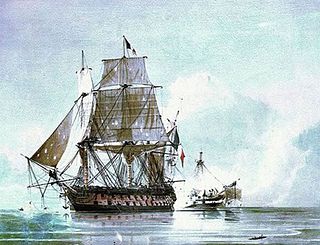Related Research Articles

HMS Leander was a Portland-class 50-gun fourth rate of the Royal Navy, launched at Chatham on 1 July 1780. She served on the West Coast of Africa, West Indies, and the Halifax station. During the French Revolutionary Wars she participated in the Battle of the Nile before a French ship captured her. The Russians and Turks recaptured her and returned her to the Royal Navy in 1799. On 23 February 1805, while on the Halifax station, Leander captured the French frigate Ville de Milan and recaptured her prize, HMS Cleopatra. On 25 April 1805, cannon fire from Leander killed an American seaman while Leander was trying to search an American vessel off the US coast for contraband. The resulting "Leander affair" contributed to the worsening of relations between the United States and Great Britain. In 1813, the Admiralty converted Leander to a hospital ship under the name Hygeia. Hygeia was sold in 1817.

USS Kirkpatrick (DE-318) was an Edsall-class destroyer escort built for the U.S. Navy during World War II. She served in the Atlantic Ocean the Pacific Ocean and provided destroyer escort protection against submarine and air attack for Navy vessels and convoys. Post-war, she was converted to a radar picket ship to support the DEW Line.
Fifteen ships of the Royal Navy have borne the name HMS Mary:
Three ships and a shore establishment of the Royal Navy have been named HMS Fisgard or HMS Fishguard after the coastal town of Fishguard in Pembrokeshire, Wales, the scene of the defeat of the last invasion attempt on Britain, by a French force in 1797 during the French Revolutionary Wars.
Ten ships of the Royal Navy have borne the name HMS Mutine :

HMS Tribune was a Royal Navy 36-gun fifth rate. This frigate was originally the French Galathée-class frigateCharente Inférieure, which was launched in 1793 during the French Revolutionary Wars and renamed Tribune the next year. The British captured her and took her into service with the Royal Navy. She only served for a year before being wrecked off Herring Cove, Nova Scotia, on 16 or 23 November 1797. Of the 240 men on board, all but 12 were lost.
Six ships of the Royal Navy have borne the name HMS Halifax, after the English town of Halifax, West Yorkshire and the city of Halifax, Nova Scotia.
Halifax commonly refers to:
Seven ships of the Royal Navy have borne the name HMS Strombolo, or HMS Stromboli, after the volcano Stromboli, in Italy:
Five ships of the Royal Navy have borne the name HMS Grappler:
Several French ships have borne the name Courageux, Courageaux, or Courageuse:
A number of vessels have been named Alexander:
A number of ships have been named Friendship:
Charles Mary Wentworth was a privateer ship built in 1798 by local investors in Liverpool, Nova Scotia, the first privateer ship from British North America in the Napoleonic Wars. The ship was named after Charles Mary Wentworth, the son of then governor of Nova Scotia, Sir John Wentworth. The ship Charles Mary Wentworth launched privateering in Nova Scotia during the Napoleonic Wars. Her success in capturing 11 valuable ships in her short two-year career led to the commissioning of a dozen other privateer ships from Nova Scotia.
HMS Busy was launched in 1797 as the only member of her class of brig-sloops. She captured one French privateer and numerous small merchantmen, but spent most of her career escorting convoys to and from the West Indies. She foundered in 1806 while serving on the Halifax, Nova Scotia, station.
Several vessels have been named African Queen:
Several ships have been named John:
Several vessels have been named Trial, or a now obsolete variant of that word:
Several vessels have been named Camilla:
Marquis de Somerulas was a United States merchant ship launched circa 1800, possibly at Charlestown, Boston. She survived an attack by Malay pirates in 1807. The British Royal Navy captured her in 1812. She probably became HMS Magnet. If so, she then served as a prison ship at Halifax, Nova Scotia. The Royal Navy eventually renamed her Attentive. As Attentive she served as a store ship, still apparently on the Halifax station, before she sailed to Britain in 1816. Attentive was broken up in January 1817.
References
- Anon. 1904. Pennsylvania Magazine of History and Biography, Volume 28, Historical Society of Pennsylvania., 1904
- Kirkpatrick, Andrea (2023). A Game of Chance: The Story of British North American South Seas Whaling. FriesenPress. ISBN 9781039158634.